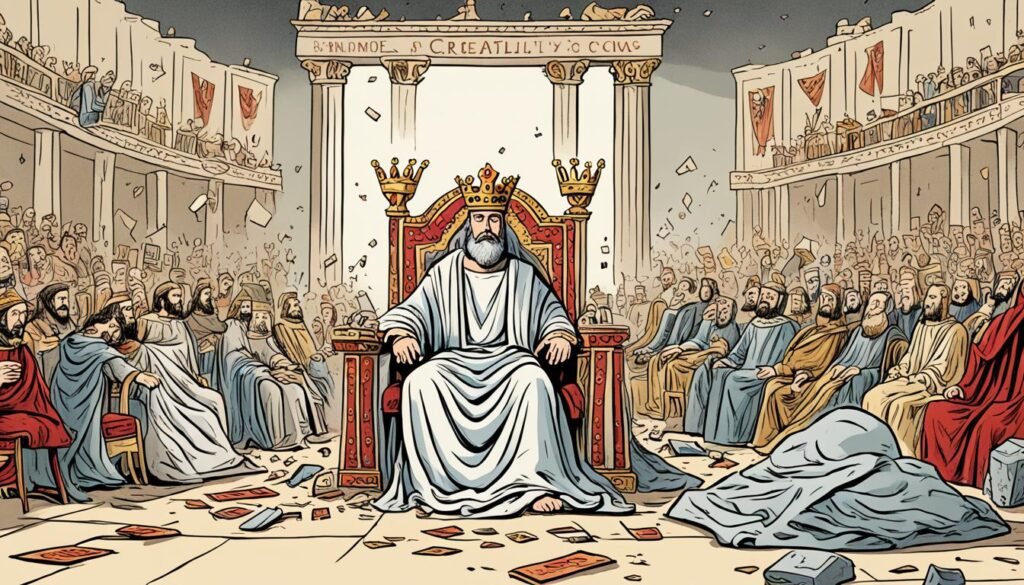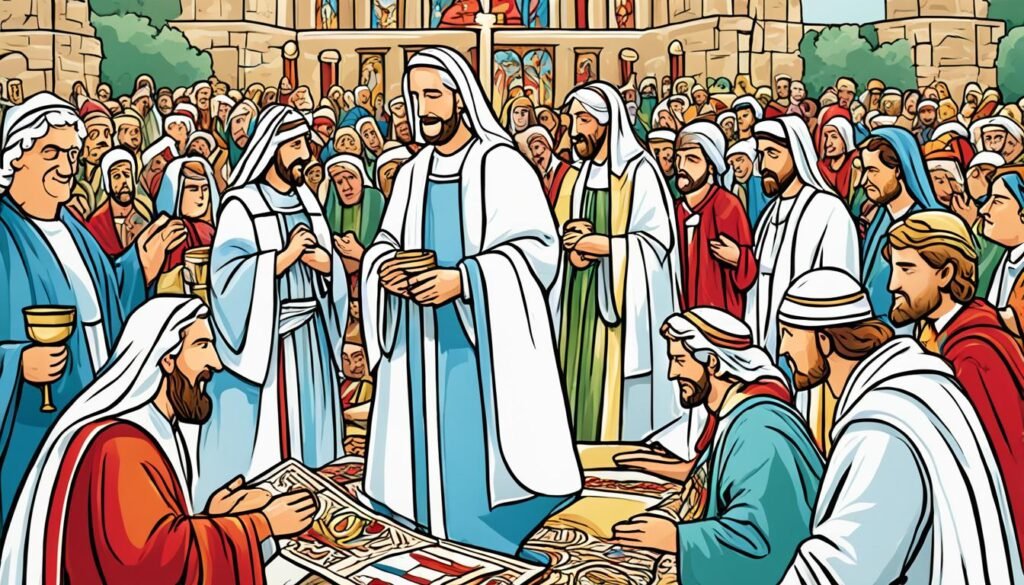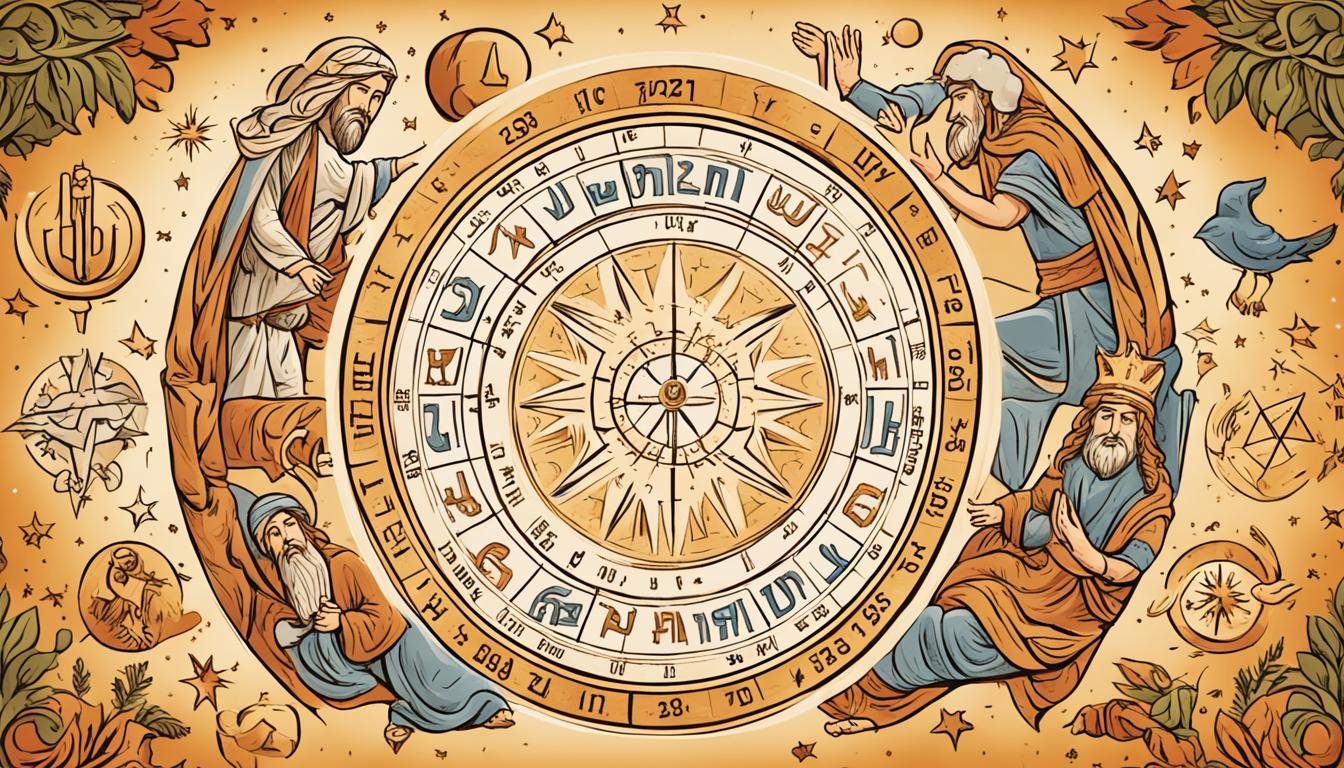The exact Hebrew year in which Jesus was born has been a topic of much debate and speculation. Historians and scholars have put forth various dates, with estimates ranging from 6 BC to 1 AC. Recent studies have supported the date established in the 6th century by Dionysius Exiguus, which places Jesus’ birth at the end of 1 BC.
The Western tradition celebrates Jesus’ birth on December 25, while the Eastern tradition observes it on January 6. However, these dates are not universally agreed upon and are based on theories rooted in both religious and historical considerations.
To dig deeper into this complex issue, let’s explore the controversies surrounding the dating of Jesus’ birth, the astronomical backgrounds of the Nativity Day, the implications of Herod’s death, the census of Quirinius, the courses of the Temple service, and the arguments for both a Tishri (Sukkot) birth and a late December birth.
Key Takeaways:
- The exact Hebrew year of Jesus’ birth is the subject of ongoing scholarly debate.
- Estimates for Jesus’ birth range from 6 BC to 1 AC, with the date at the end of 1 BC gaining support.
- Both the Western and Eastern traditions have specific dates for celebrating Jesus’ birth, but these dates are not universally accepted.
- Controversies surrounding the dating of Jesus’ birth involve theories connected to pagan feasts, religious symbolism, and historical events.
- The implications of Herod’s death and the census of Quirinius play a significant role in narrowing down possible years for Jesus’ birth.
Controversies Surrounding the Dating of Jesus’ Birth
The dating of Jesus’ birth has sparked heated controversies and ongoing scholarly debates. Various theories and hypotheses have emerged, challenging the traditional dates of December 25 and January 6 for Jesus’ birth.
One notable theory proposes that December 25 was chosen as a replacement for the pagan feast of the birth of Sol Invictus, the sun god. Critics argue that this date was selected to align with existing pagan celebrations and facilitate the conversion of pagans to Christianity.
Another theory suggests a calculation method based on Jesus’ Passion Day, correlating it to his birth. Advocates argue that Jesus, carrying the weight of human sin, would have been conceived and crucified on the same day during the spring equinox.
The Eastern tradition provides yet another perspective, linking Jesus’ birth to significant pagan feasts. Some propose a connection with the birth of Aion, the god of eternity, celebrated on December 25. Others suggest a correlation with the water withdrawal of the Nile River, an event of great importance in ancient Egypt.
The controversies surrounding the dating of Jesus’ birth reveal the intricate interplay between religion, history, and cultural practices. These debates reflect the complexities of forming a consensus on this significant event.
Despite the multitude of arguments and discussions, a definitive consensus has yet to be reached regarding the exact date of Jesus’ birth. The controversy continues to stimulate scholarly research and fosters a deeper understanding of the historical and cultural implications surrounding the remarkable nativity.
The Astronomical Backgrounds of the Nativity Day
To establish the possible connection between the Nativity Day and the Hebrew feast of Hanukkah (Kislev 25), it is necessary to examine the astronomical backgrounds. This involves converting dates from the luni-solar calendar to the Julian calendar and considering factors such as embolismic years and leap years. Different theories have proposed the correlation between December 25 or January 6 and Kislev 25. However, the accuracy and historical reliability of these correlations remain subjects of study and further research.
“The astronomical backgrounds shed light on the possible connection between the Nativity Day and Hanukkah. By examining the calendar conversions and considering the influence of embolismic and leap years, researchers have proposed various correlations between December 25 or January 6 and Kislev 25.”
The Implications of Herod’s Death
The death of Herod the Great has significant implications for understanding the possible years of Jesus’ birth. Historical evidence and Biblical accounts suggest that Herod’s death occurred just after Nisan 1 in the spring, two weeks before Passover, specifically in 4 BC.
This timeframe places constraints on the potential dates for Jesus’ birth, limiting them to the years before 4 BC. Furthermore, when considering the timeline of events such as the massacre of the Bethlehem innocents, the visitation of the Magi, and the events surrounding Herod’s reign, a narrower focus falls on around 6 BC as the probable year of Jesus’ birth.
The death of Herod the Great, therefore, serves as a crucial historical marker in piecing together the puzzle of Jesus’ birth. By examining the implications of Herod’s demise and its alignment with other significant events, scholars can gain valuable insights into the chronology of Jesus’ life and ministry.

Herod’s Reign and Biblical Accounts
Herod the Great, also known as Herod I, was a prominent figure during the time of Jesus’ birth. He ruled Judea as a client king under Roman authority from 37 BC until his death in 4 BC. Herod’s reign was characterized by a mix of impressive architectural projects, political intrigue, and ruthless leadership.
When Herod saw that he had been tricked by the Magi, he became enraged, and he sent and killed all the male children in Bethlehem and in all that region who were two years old or under, according to the time that he had ascertained from the Magi.” (Matthew 2:16)
The Biblical account of Herod’s pursuit of the newborn Jesus reinforces the historical context of his reign. The infanticide in Bethlehem, known as the “Massacre of the Innocents,” aligns with the timing of Herod’s death, further bolstering the connection between these events.
Implications and Historical Significance
The implications of Herod’s death extend beyond merely establishing the potential years of Jesus’ birth. By understanding the political and cultural climate of the region during this time, historians can gain valuable insights into the context in which Jesus began his ministry.
Herod’s death marked the end of a tumultuous era and paved the way for subsequent political changes. This transition laid the groundwork for the ministry of John the Baptist and Jesus, ultimately shaping the course of their teachings and the events surrounding their lives.
Additionally, exploring the implications of Herod’s death allows for a deeper understanding of the religious and geopolitical underpinnings that influenced the birth and early impact of Christianity. By comprehending the historical significance of this pivotal event, scholars can piece together a more comprehensive picture of Jesus’ life and the societal backdrop in which he lived.
The Census of Quirinius
The reference to a census in Luke 2:2 plays a significant role in the narrative of Jesus’ birth, as it led Mary and Joseph to Bethlehem. However, the specifics regarding the timing of this census and its connection to the Roman governor Quirinius have been subjects of debate among scholars.
One theory proposes that the census mentioned in Luke’s account corresponds to a historical event that took place in 6 AD when Quirinius was the governor of Syria. This theory suggests that the term “governing” in Luke 2:2 refers to Quirinius being the governor at the time of the census.
However, this theory has faced challenges and alternative interpretations. Some researchers argue that Quirinius’ governorship did not coincide with the traditional timeframe of Jesus’ birth, which is usually associated with the reign of Herod the Great.
These debates highlight the complexities involved in reconciling biblical accounts with historical records. The search for historical accuracy and understanding of the census of Quirinius continues to be an area of ongoing investigation and scholarly discourse.
The reference to the census of Quirinius is a fascinating aspect of the Nativity story, raising questions about the historical context in which Jesus was born.
Alternative Explanations and Interpretations
Some scholars propose alternative explanations and interpretations regarding the census of Quirinius. One theory suggests that there were multiple censuses conducted by Quirinius during his administration, and the one mentioned in Luke’s account may have been an earlier census that took place before Herod’s death.
- This theory argues that the census mentioned in Luke was an earlier registration for taxation purposes and was not related to the census of 6 AD.
- Another interpretation suggests that the Greek term translated as “governing” in Luke 2:2 can also be understood as “was governor” or “formerly governing.” These alternative translations propose that Quirinius had a prior governing role in the region.
Proposed Theories on the Census of Quirinius
| Theory | Explanation |
|---|---|
| The Census of 6 AD | The census mentioned in Luke 2:2 corresponds to the historical census conducted in 6 AD during Quirinius’ governorship. |
| Multiple Censuses | Quirinius conducted multiple censuses, and the one mentioned in Luke may have been an earlier census unrelated to the 6 AD event. |
| Alternative Translation | The Greek term translated as “governing” in Luke 2:2 can also be translated as “was governor” or “formerly governing,” suggesting Quirinius had a prior role in the region. |
Courses of the Temple Service
The Temple service and the assigned courses of priests provide another avenue for investigating the possible dates of Jesus’ birth. King David divided the sons of Aaron into 24 courses, and lots were drawn to determine the sequence of their service in the Temple. The eighth course, known as the “Course of Aviyah,” is of particular interest as Zechariah, John the Baptist’s father, served during this course. By examining the timing and rotation of the courses, it is possible to infer the approximate time of John’s conception and subsequently Jesus’ birth.

Argument for a Tishri (Sukkot) Birth
One argument proposes that Jesus’ birth occurred in the fall, specifically during the festival of Sukkot (Tabernacles), based on the connection between his birth and the conception of John the Baptist. The dates for John’s conception and birth can be inferred from the course of Aviyah, which aligns with late Sivan for conception and Nisan for birth. By adding six months to John’s birth, Jesus’ conception is estimated to have taken place in Kislev, leading to a birth in Tishri during the Sukkot festival.
This theory finds support in the symbolism and significance of Sukkot, as well as the alignment of events described in the New Testament. Sukkot is a holiday that commemorates the time the Israelites spent in temporary shelters during their journey in the wilderness. It represents God dwelling among His people and the hope of salvation. Jesus’ birth during Sukkot would connect His arrival with the anticipation of the Messiah and emphasize God’s presence and provision for His people.
| Pros | Cons |
|---|---|
| Symbolic connection to Sukkot and the Messianic hope | Dependent on the accuracy of the course of Aviyah |
| Aligns with the narrative of God’s provision and presence | Interpretation of the course of Aviyah may vary |
| Potential correlation between the birth of Jesus and Sukkot traditions | Requires assumptions about the timing of John the Baptist’s birth |
In conclusion, the argument for a Tishri (Sukkot) birth suggests that Jesus was born during the fall festival, aligning with the symbolism and significance of Sukkot and the narrative of God’s provision and presence. While this theory relies on the course of Aviyah and assumptions about John the Baptist’s birth, it offers a unique perspective on the timing of Jesus’ birth and its connection to the Jewish festivals.
Argument for a Late December Birth
One argument proposes a late December birth for Jesus based on the assumption that Zechariah was told about Elizabeth’s conception during Yom Kippur (the Day of Atonement). This theory suggests that John the Baptist was conceived after Yom Kippur and born around Tammuz. With Jesus’ conception occurring six months later, it is posited that it took place during late Kislev, near the time of Chanukah, leading to a birth in Tishri during the traditional late December date. This argument draws connections between the events surrounding Jesus’ birth and the cultural and religious context of the time.

One intriguing argument for a late December birth of Jesus is based on the assumption that Zechariah, John the Baptist’s father, received the revelation of Elizabeth’s conception during Yom Kippur, which falls in late September or early October. According to this theory, John the Baptist was conceived soon after Yom Kippur and born around the month of Tammuz. If we consider Jesus’ conception six months after John’s, it is posited that it occurred during late Kislev, close to the time of the Jewish festival of Chanukah.
This argument suggests that Jesus’ birth would have taken place in the month of Tishri, which aligns with the traditional late December date observed in Western Christian tradition. By drawing connections between the events surrounding Jesus’ birth and the cultural and religious context of that time, proponents of this theory support a late December birth for Jesus.
Historical Context and Implications
The historical context surrounding the birth of Jesus is complex and multifaceted. With various theories and debates regarding the specific dates and timing of Jesus’ birth, historians and scholars face challenges in determining an exact year and day. These discussions have profound implications for religious, cultural, and historical understanding, reflecting the diverse perspectives and interpretations of Jesus’ birth across different traditions.
The implications of different historical interpretations hold significant religious and cultural importance. They contribute to a deeper understanding of the historical context in which Jesus’ birth took place and shed light on the religious significance of this pivotal moment in history. By delving into these debates, researchers and scholars can uncover new insights and connections that shape our understanding of the time period and the impact of Jesus’ birth.
“The historical context of Jesus’ birth provides a framework for comprehending its deeper significance and understanding its implications on religious faith and cultural practices.”
Exploring the historical context of Jesus’ birth enables us to connect the dots between the religious, socio-political, and cultural milieu of the time. This understanding helps contextualize the events surrounding Jesus’ birth and their implications for the development of Christianity. By examining the historical context, researchers can unravel the intricate tapestry of the first century and its impact on the birth and early years of Jesus.
Interpretations of the Historical Context
Various interpretations of the historical context provide insights into different aspects of Jesus’ birth. Some scholars focus on the interactions between Judaism and Roman rule, highlighting the influence of the Roman Empire on religious practices and the wider geopolitical implications of Jesus’ birth within this framework.
Others explore the social and cultural context of ancient Palestine, examining the lives of ordinary people and the significance of Jesus’ birth within their communities. This perspective sheds light on the implications of Jesus’ birth for the people of that time, offering a glimpse into their hopes, aspirations, and expectations.
Relevance in Contemporary Society
The historical context and implications of Jesus’ birth continue to be important areas of study not only for historians and scholars but also for individuals seeking a deeper understanding of their own religious faith and cultural heritage. By examining the historical context and the implications of Jesus’ birth, we gain valuable insights into the origins and development of Christianity, as well as the enduring significance of Jesus’ teachings and life.
Understanding the historical context of Jesus’ birth allows us to appreciate and contextualize the impact of this event on subsequent religious and cultural developments. It offers a foundation for dialogue and exploration of the rich tapestry of religious beliefs and practices that emerged from this pivotal moment in history.
Conclusion
In conclusion, the question of what Hebrew year Jesus was born in remains unanswered definitively. The dating of Jesus’ birth continues to be a subject of scholarly debate, and various theories have been proposed to calculate the specific date. The controversy surrounding the Western tradition of celebrating Jesus’ birth on December 25 and the Eastern tradition on January 6 reflects the complexities and historical uncertainties surrounding this topic. Further research and study are needed to shed more light on the exact Hebrew year of Jesus’ birth and its historical significance.
FAQ
What Hebrew year was Jesus born?
The exact Hebrew year in which Jesus was born is a subject of much debate and speculation. Historians and scholars have proposed various dates ranging from 6 BC to 1 AC. Recent studies have supported the date established in the 6th century by Dionysius Exiguus, which sets Jesus’ birth at the end of 1 BC.
What controversies surround the dating of Jesus’ birth?
The dating of Jesus’ birth has been a topic of controversy and scholarly debate. Many theories and hypotheses have been put forth, including alternative explanations for the dates of December 25 and January 6. Despite ongoing discussions, a consensus has yet to be reached regarding the exact date of Jesus’ birth.
What are the astronomical backgrounds of the Nativity Day?
To establish the possible connection between the Nativity Day and the Hebrew feast of Hanukkah (Kislev 25), it is necessary to examine the astronomical backgrounds. Different theories have proposed the correlation between December 25 or January 6 and Kislev 25. However, the accuracy and historical reliability of these correlations remain subjects of study and further research.
What are the implications of Herod’s death?
The death of Herod the Great plays a significant role in establishing the possible years for Jesus’ birth. Based on historical evidence and biblical accounts, Herod’s death is believed to have occurred just after Nisan 1 in the spring, two weeks before Passover, in 4 BC. This restricts the potential dates for Jesus’ birth to the years before 4 BC, with a narrower focus on around 6 BC considering the timeline of the Bethlehem innocents, the visitation of the Magi, and the events surrounding Herod’s reign.
What is the census of Quirinius?
The reference to a census in Luke 2:2, which led Mary and Joseph to Bethlehem, has been a topic of investigation. Various theories have been proposed to reconcile Luke’s account with the historical reality of a census taking place in 6 AD when Quirinius was governor of Syria. Scholars have explored different interpretations of the term “governing” and its implications for understanding the census and its relation to the birth of Jesus.
What are the courses of the Temple service?
The Temple service and the assigned courses of priests provide another avenue for investigating the possible dates of Jesus’ birth. By examining the timing and rotation of the courses, it is possible to infer the approximate time of John the Baptist’s conception and subsequently Jesus’ birth.
What is the argument for a Tishri (Sukkot) birth?
One argument for Jesus’ birth occurring in the fall, specifically during the festival of Sukkot (Tabernacles), is based on the conception of John the Baptist and the connection between their two births. This theory is supported by the symbolism and significance of Sukkot and the alignment of events described in the New Testament.
What is the argument for a late December birth?
Another argument proposes a late December birth for Jesus based on the assumption that Zechariah was told about Elizabeth’s conception during Yom Kippur (the Day of Atonement). This theory suggests that John the Baptist was conceived after Yom Kippur and born around Tammuz. This argument draws connections between the events surrounding Jesus’ birth and the cultural and religious context of the time.
What is the historical context and implications of Jesus’ birth?
The historical context surrounding the birth of Jesus is complex and multifaceted. The various theories and debates highlight the challenges faced by historians and scholars in determining an exact year and day. These discussions contribute to a deeper understanding of the historical and religious significance of this pivotal moment in religious history.
What is the conclusion regarding the Hebrew year Jesus was born?
In conclusion, the question of what Hebrew year Jesus was born in remains unanswered definitively. The dating of Jesus’ birth continues to be a subject of scholarly debate, and various theories have been proposed to calculate the specific date. Further research and study are needed to shed more light on the exact Hebrew year of Jesus’ birth and its historical significance.
Source Links
- https://www.scirp.org/journal/paperinformation.aspx?paperid=120038
- https://biblearchaeology.org/research/the-daniel-9-24-27-project/4368-pinpointing-the-date-of-christ-s-birth
- https://www.hebrew4christians.com/Articles/Christmas/christmas.html

I’m Benjamin, a passionate spiritual seeker and creator of Verses and Prayers. Alongside my girlfriend Emma and our pet lizard Mulle, I cherish family life, enjoy exploring new places, and am deeply involved in my church community. My love for reading and singing biblical verses inspires every aspect of my journey.

